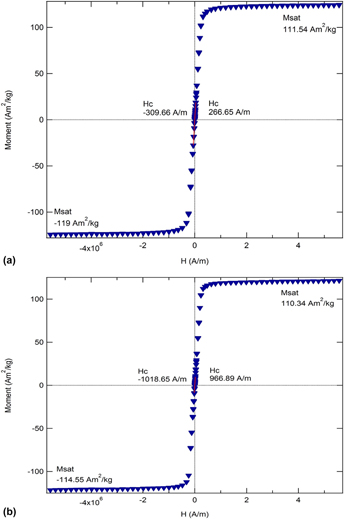Crossref Citations
This article has been cited by the following publications. This list is generated based on data provided by
Crossref.
Fu, Zhiqiang
MacDonald, Benjamin E.
Li, Zhiming
Jiang, Zhenfei
Chen, Weiping
Zhou, Yizhang
and
Lavernia, Enrique J.
2018.
Engineering heterostructured grains to enhance strength in a single-phase high-entropy alloy with maintained ductility.
Materials Research Letters,
Vol. 6,
Issue. 11,
p.
634.
Fu, Zhiqiang
Hoffman, Andrew
MacDonald, Benjamin E.
Jiang, Zhenfei
Chen, Weiping
Arivu, Maalavan
Wen, Haiming
and
Lavernia, Enrique J.
2019.
Atom probe tomography study of an Fe25Ni25Co25Ti15Al10 high-entropy alloy fabricated by powder metallurgy.
Acta Materialia,
Vol. 179,
Issue. ,
p.
372.
Fu, Zhiqiang
MacDonald, Benjamin E.
Dupuy, Alexander D.
Wang, Xin
Monson, Todd C.
Delaney, Robert E.
Pearce, Charles J.
Hu, Ke
Jiang, Zhenfei
Zhou, Yizhang
Schoenung, Julie M.
Chen, Weiping
and
Lavernia, Enrique J.
2019.
Exceptional combination of soft magnetic and mechanical properties in a heterostructured high-entropy composite.
Applied Materials Today,
Vol. 15,
Issue. ,
p.
590.
Zhao, Rui-Feng
Ren, Bo
Cai, Bin
Liu, Zhong-Xia
Zhang, Guo-Peng
and
Zhang, Jian-jian
2019.
Corrosion behavior of CoxCrCuFeMnNi high-entropy alloys prepared by hot pressing sintered in 3.5% NaCl solution.
Results in Physics,
Vol. 15,
Issue. ,
p.
102667.
Mishra, Rajesh K.
and
Shahi, Rohit R.
2020.
A novel low-density semi-hard magnetic Al20Fe20Mg20Ni20Ti20 high entropy alloy.
Journal of Magnetism and Magnetic Materials,
Vol. 516,
Issue. ,
p.
167342.
Lu, Tiwen
He, Tianbing
Zhao, Panpan
Sun, Kang
Andreoli, Angelo F.
Chen, Hongyu
Chen, Weiping
Fu, Zhiqiang
and
Scudino, Sergio
2021.
Fine tuning in-sync the mechanical and magnetic properties of FeCoNiAl0.25Mn0.25 high-entropy alloy through cold rolling and annealing treatment.
Journal of Materials Processing Technology,
Vol. 289,
Issue. ,
p.
116945.
Mishra, Rajesh K.
Kumari, Priyanka
Gupta, Amit K.
and
Shahi, Rohit R.
2021.
Design and development of Co35Cr5Fe20−xNi20+xTi20 High Entropy Alloy with excellent magnetic softness.
Journal of Alloys and Compounds,
Vol. 889,
Issue. ,
p.
161773.
Khakurel, Hrishabh
Taufique, M. F. N.
Roy, Ankit
Balasubramanian, Ganesh
Ouyang, Gaoyuan
Cui, Jun
Johnson, Duane D.
and
Devanathan, Ram
2021.
Machine learning assisted prediction of the Young’s modulus of compositionally complex alloys.
Scientific Reports,
Vol. 11,
Issue. 1,
Bazioti, C.
Løvvik, O.M.
Poulia, A.
Carvalho, P.A.
Azar, A.S.
Mikheenko, P.
Diplas, S.
and
Gunnæs, A.E.
2022.
Probing the structural evolution and its impact on magnetic properties of FeCoNi(AlMn)x high-entropy alloy at the nanoscale.
Journal of Alloys and Compounds,
Vol. 910,
Issue. ,
p.
164724.
Alijani, Fatemeh
Reihanian, Mohsen
Gheisari, Khalil
Edalati, Kaveh
and
Miyamoto, Hiroyuki
2022.
Effect of Homogenization on Microstructure and Hardness of Arc-Melted FeCoNiMn High Entropy Alloy During High-Pressure Torsion (HPT).
Journal of Materials Engineering and Performance,
Vol. 31,
Issue. 6,
p.
5080.
Zhang, Quan
Zhang, Shusheng
Luo, Yang
Liu, Qian
Luo, Jun
Chu, Paul K.
and
Liu, Xijun
2022.
Preparation of high entropy alloys and application to catalytical water electrolysis.
APL Materials,
Vol. 10,
Issue. 7,
Kumari, Priyanka
Gupta, Amit K.
Mishra, Rajesh K.
Ahmad, M.S.
and
Shahi, Rohit R.
2022.
A Comprehensive Review: Recent Progress on Magnetic High Entropy Alloys and Oxides.
Journal of Magnetism and Magnetic Materials,
Vol. 554,
Issue. ,
p.
169142.
Zeraati, Malihe
Khazaei Feizabad, Mohammad Hossein
and
Khayati, Gholam Reza
2023.
An investigation of the magnetic, mechanical, and kinetic characteristics of CuCrFeTiNi high entropy alloy by mechanical alloying and spark plasma sintering.
Journal of Alloys and Compounds,
Vol. 958,
Issue. ,
p.
170347.
Dong, Peilin
Huang, Liufei
Yang, Qiuju
Ren, Congcong
Zhou, Yuanfeng
Zhong, Zhiyong
and
Li, Jinfeng
2023.
Simultaneously enhancing strength and ductility of multiprincipal-element soft magnetic alloys.
Materials Today Communications,
Vol. 37,
Issue. ,
p.
107010.
Chen, Tao
Chen, Weiping
Jiang, Zhenfei
Zhu, Dezhi
and
Fu, Zhiqiang
2023.
An in-situ formed TiC/FeCoNi medium-entropy composite with excellent combination of mechanical and soft magnetic properties.
Vacuum,
Vol. 218,
Issue. ,
p.
112601.
Chen, Tao
Chen, Weiping
Wu, Renjun
Chu, Chenliang
Jiang, Zhenfei
and
Fu, Zhiqiang
2023.
Microstructure and properties of TiC/Fe24Ni24Co24Mn18 high-entropy composite with exceptionally low coercivity.
Materials Today Communications,
Vol. 35,
Issue. ,
p.
106150.
Wang, Xin
Zhu, Guanjun
Liu, Jia
Lei, Yuhui
Zhang, AMei
Hou, Hongping
Zhang, Yunpeng
and
Du, Hongliang
2023.
Microstructural evolution and mechanical properties of novel nanoparticles strengthened CoCrFeNi based high entropy alloy.
Journal of Materials Research and Technology,
Vol. 25,
Issue. ,
p.
7325.
Klenam, Desmond E.P.
Egowan, Gaston
Bodunrin, Michael O.
van der Merwe, Josias W.
Rahbar, Nima
and
Soboyejo, Winston
2023.
Comprehensive Structural Integrity.
p.
50.
Duan, Jiacheng
Wang, Mingliang
Huang, Rui
Miao, Junwei
Lu, Yiping
Wang, Tongmin
and
Li, Tingju
2023.
A novel high-entropy alloy with an exceptional combination of soft magnetic properties and corrosion resistance.
Science China Materials,
Vol. 66,
Issue. 2,
p.
772.
Chen, Wanqing
Li, Bo
Yang, Han
Xu, Lei
Ye, Xicong
and
Fang, Dong
2023.
Effect of B content on microstructure and mechanical properties of (Co30Cr25Fe40Ni5)100-xBx high-entropy alloys.
Journal of Materials Research,
Vol. 38,
Issue. 12,
p.
3187.
